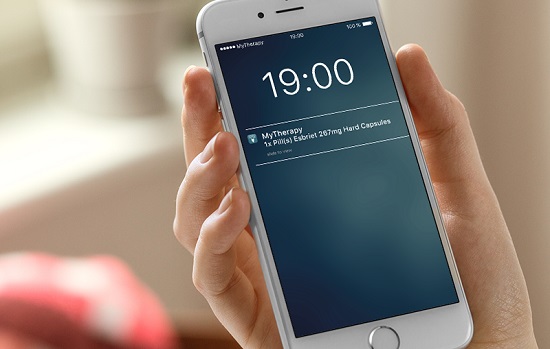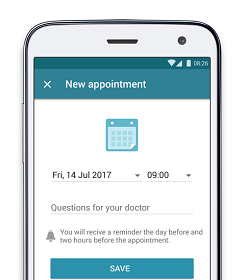Life with IPF: Manage Your Idiopathic Pulmonary Fibrosis and Control Your Symptoms with a Smartphone App
You Need All the Support You Can Get When Living with IPF. Find out How MyTherapy Can Help You Manage Your Medication and Improve Your Well‑Being

The word ‘pulmonary’ refers to the lungs and ‘fibrosis’ means scar tissue. Therefore, pulmonary fibrosis (PF) (on a basic level) is the scarring of the lungs. There are many different types of PF, the most common being idiopathic pulmonary fibrosis (IPF). It is a very serious condition that can lead to various complications, such as pneumonia and respiratory failure. As the condition progresses, the scar tissue can destroy your lungs, making it difficult for oxygen to get into your blood. IPF differs from PF because there is no known cause for IPF (there are known causes for PF). The inclusion of the word ‘idiopathic’ means that this type of fibrosis has no known cause. Although there is currently no cure for the condition and it is terminal, you can manage your symptoms and slow down its progression by taking medication responsibly and strictly. However, it is not always easy to adhere to your medication regimen, especially if you have to take a multitude of drugs at various times during the day. For this reason, smartpatient developed MyTherapy - a reliable medication and health tracker app that has been proven to increase adherence rates.
Living with IPF is challenging and it is important that you take your medication properly in order to help with symptom relief and slowing the progression of the condition. MyTherapy, a medication and health tracker app, was designed to help people living with chronic illnesses, like IFP, adhere to their medication and improve their quality of life. While taking medication seems like a simple-enough task, it can become a challenge when the treatment regimen is a complex one. It is therefore important that you have a system in place to remind you when to take your medication. With MyTherapy, you’ll have everything you need to help you track your health and medication intake. The app generates reminders via both an alarm and pop-up notification that you can use for both medication intake and doctors’ appointments. Your only task is to upload your medication (manually, via the app’s barcode scanner, or via the app’s built-in database) and other relevant info and the app will do the rest for you. Medication adherence is therefore turned into a simple, everyday to-do list, meaning that you are less likely to forget to take your pills. MyTherapy also includes a digital health diary, which you can use to track your symptoms, health measurements (e.g. weight, breath frequency, breath volume), and physical activity. All the data that you log in the app can be printed out in the form of a monthly health report that you can share with your doctor. This makes it easier for both you and your doctor to find the right therapy plan that best suits your needs so that you can improve the quality of your life.
MyTherapy is designed in a user-friendly way and the team at smartpatient, the company responsible for MyTherapy, continuously strives to make the app better for you. You also don’t have to worry about your data as MyTherapy adheres to strict German privacy laws. Furthermore, you can also set a passcode (or fingerprint scanner) on the app, ensuring that only you have access to the app. It doesn’t matter how old you are - the app is simple and easy to use and you can even invite friends and family on the app for extra support.
Some Background Info
Idiopathic pulmonary fibrosis (IPF) is the most common type of interstitial lung disease (ILD). ILDs affect the interstitium, a lace-like tissue network that supports the air sacs of the lungs. The lungs are made up by a series of progressively smaller airways. Normally, the air you breathe in travels down the windpipe (trachea) and into two smaller airway tubes called bronchi. The bronchi divide and become progressively smaller, turning into bronchioles and then into millions of tiny air vesicles called alveoli. For oxygen to get into your bloodstream, it needs to pass through the thin-walled alveoli of the lungs into the nearby blood vessels.
In idiopathic pulmonary fibrosis, the lungs become inflamed and a scar tissue called fibrosis is formed. This makes the lungs thick, hard, and less elastic. As a result, oxygen has difficulty passing from the alveoli in the lungs to the bloodstream. In the long term, this can lead to various complications such as very high levels of red blood cells, high blood pressure, respiratory failure, or collapsed lungs. The most common symptom is shortness of breath, even during activities that would not usually tire you out (for example getting dressed). The symptoms of IPF usually develop slowly and worsen over time. However, it is also possible for a sudden worsening of the condition. In some cases, the symptoms remain stable and then suddenly flare up in an episode called acute exacerbation. Signs and symptoms of IPF can include:
- Shortness or breath and/or cough lasting for at least six months
- Fatigue
- Mild fevers
- Weigh loss
- Joint discomfort
- Muscle pain
- Clubbing or enlargement of fingers
- Ankle swelling
- Heart murmur
Often people attribute the feelings of breathlessness and tiredness to old age. However, it is important not to ignore these symptoms and you should see a doctor as soon as possible. If your GP suspects that you have IPF, he or she will do a physical examination, ask about your medical history, and conduct various tests. The tests may include lung function tests, blood tests, chest X-rays, computerized tomography (CT) scans, and a lung biopsy. Together, the tests and examinations will help your GP make a diagnosis and rule out other forms of interstitial lung diseases.
IPF usually affects people who are between 70 and 75 years of age. It is rarely diagnosed in people under 50. The condition is relatively rare: it affects around 2 in 10,000 people. In 2012, about 32,500 people had IPF in the UK.
‘Idiopathic’ Means That the Cause Is Unknown
It is unclear what causes IPF. In fact, the term ‘idiopathic’ means that the cause is not known. However, several risk factors have been identified that appear to increase the chance of developing IPF. These risk factors include:
- Viral infections (for example Epstein-Barr, herpes, hepatitis C)
- Being exposed to certain types of dust and hazardous materials
- Having a family member who has been diagnosed with IPF (1 in 20 people have relatives with the disease)
- Smoking
- Suffering from gastro-oesophagal reflux disease (GORD)
Treatment Options
There is no cure for IPF, but advancements in research allow people with IPF to love longer and have a better quality of life. No doctor is able to predict how long you can live with IPF and patients experience disease progression at different rates. If you have been diagnosed with IPF, you need to learn how to take care of yourself by consulting a healthcare professional. It is possible to relieve the symptoms and slow down the progression of the condition with various types of treatments. You will need to make lifestyle adjustments, which can include stopping smoking, exercising regularly, eating a healthy and balanced diet, getting your annual flu vaccination, and staying away from people with chest infections or colds.
You will also be advised to take medication. There are two main types of medication that are used to slow down the course of the disease. They are usually taken as capsules several times a day. For example, pirfenidone (Esbriet) reduces the activity of the immune system, which slows down the scarring of the lungs. Nintedanib (Ofev) is a newer drug that also reduces lung scarring. There is also some limited evidence that N-acetylcysteine can help reduce scarring of the lungs. However, there it is no confirmation that N-acetylcysteine is an effective drug against IPF.
There are also several other forms of treatment that can help reduce the symptoms of IPF. These can include:
- Oxygen therapy to make breathing and exercise easier
- Lung rehabilitation in the form of physical exercise and breathing techniques
In more severe cases of IPF, lung transplantation may be an option.
Better Breathing with MyTherapy
Idiopathic pulmonary fibrosis is a chronic and terminal lung condition that requires treatment via medication, therapy, and self-care. Although it may sound simple, it is not easy to remember all the pills you need to take or doctors’ appointments you need to attend. You therefore need as much support as possible - and what better way to get this support in the form of an easy-to-use smartphone app. Never skip a dose and stay in control with the app’s personalized medication reminders and built-in health diary that can help you monitor your condition. Use the app to work closely with your doctors and improve your quality of life by managing your symptoms effectively.
Sources
- www.nhs.uk/Conditions/pulmonary-fibrosis
- www.blf.org.uk/support-for-you/idiopathic-pulmonary-fibrosis
- medlineplus.gov
- patient.info/health/idiopathic-pulmonary-fibrosis
- ww.breathingmatters.co.uk/idiopathic-pulmonary-fibrosis
- www.pulmonaryfibrosis.org/life-with-pf
- www.lung.org/lung-health-and-diseases
- www.medicinenet.com/idiopathic_pulmonary_fibrosis_ipf popupyes
- www.mayoclinic.org/diseases-conditions/pulmonary-fibrosis


